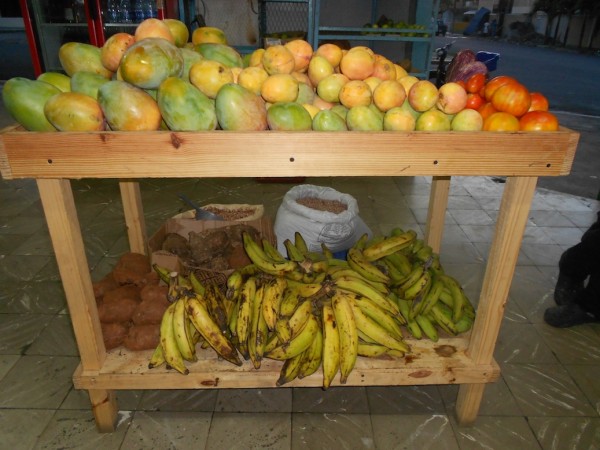I have been away from the Dominican Republic for so long, eight months, that, in coming back I can experience it more as an outsider while still retaining my inside perspective.

Heat
The first thing I feel is the heat which is so intense, enveloping and relentless that one has no choice but to wilt. Unless you are headed for a resort, air-conditioning is rare — even those that can afford it usually just have it in the bedroom and only a few stores and taxis are air-conditioned but mostly you have to deal with the heat. When I lived in the Dominican Republic for eight years I never had air conditioning, ceiling fans yes, but air-conditioning no. I got used to it an except for a few days a year I was fine, but now I’m spoiled. I keep my apartment on the warm side but I’m used to the drier air, the comfort.
Beer
Back in the Dominican Republic I feel physically heavy with the heat and I immediately understand why beer is such a popular beverage. Beer is the only beverage you can get ice cold. Water, soda, juice, milk you can get cold but beer from the local colmado (convenience store) is nearly frozen and they’ll deliver it to you almost any time of day for no extra charge. In fact, a beer is usually referred to just as “una fria” (a cold one).
So despite my renewed dedication to nutrition and exercise, including my plan not to have beer while I’m here, I realize quickly that I am fighting a losing battle in this heat.

Avocados
My home in the Dominican Republic, as my ex calls it, is modest. It is only two rooms plus a bathroom. It is on the second floor and the first room (kitchen/dining/living) has a window that overlooks a huge avocado tree with ripe avocados hanging off, almost within an arms reach. Avocados are one of the best things about the Dominican Republic, especially when they are in season and you have a big avocado tree by your house.
Avocados are a source of pride in the Dominican Republic. It is one of the few vegetables they eat plain. You can buy avocados on the street, in a local market (colmado) or just pick them off a tree. To assure the quality of a given avocado, Dominicans willing cut the avocado open to demonstrate how good it is.
Noise
One thing one needs to get used to in Santo Domingo is the level of noise. It is never quiet here, just different degrees of noise. The base sounds are barking dogs, distant traffic, and construction. In Santo Domingo there is always construction, constant construction of new apartments that advertise special move in rates but mostly remain vacant. All the building is performed by Haitians who live onsite in little shacks. Most, if not all, are here illegally.
Above the base sounds you’ll here the music, especially at night, people talking loudly (Dominicans have no sense of how loud they are or just do not care), and the street vendors harping their wares: fruit, scrap metal, knife sharpening and more.
Transport
If one travels around by public transportation, be prepared for an adventure. We mostly travel around the city via local transport (buses and public cars), saving the taxis for special occasions, to keep cost down. The buses are noisy and dirty. There is no emission control and plumes of black smoke emit out of vehicles, enveloping the bus when it’s waiting at stops. The buses stop anywhere, instead of formal stops, making travel very inefficient. The drivers are daredevils, putting stunt drivers to shame, as they speed along the road, coming within inches (literally) of other vehicles.

The public cars are not much better, cramming two people, no matter the size into the front passenger seat and four in the back. One learns to give up on personal space.
Bathrooms
Another thing I’ve learned when I travel around the Dominican Republic, one needs to always bring some tissue and disinfectant wipes as almost all bathrooms are without paper and also without an actual seat. Instead one must crouch over in a hover and hope for the best. Usually the sink, if there even is one, isn’t much better, hence the need for the wipes.
Time
Time in the Dominican Republic is best described as “Tropical Time” since there is not sense of time in the Western sense. In business meetings, I will arrive on time and invariably find that the client is not in the office. After waiting a half hour, I will ask the receptionist who may, if I request, call the client, to which I am informed “is now leaving”. Another half an hour or more goes by, I inquire again and another call is made. Now the client is “arriving” but it still takes at least 15 minutes or more before they actually get there. I’ve tried to come late to my appointments to see if I can outwit this problem but it seems the client is always just as late, no matter who the client may be.
In fact, when talking about time in the Dominican Republic, I have learned to decode the language. So here is the key as I have learned it.
- vengo pronto (coming soon) or vengo ahorita (coming in a little bit) = a long time from now
- vengo ahora (coming now) = usually within a few hours
- vengo ahora mismo (coming right now) = within the hour (one hopes)
- estoy saliendo (I am leaving) = about 15-20 minutes before they really leave.
- estoy en camino (on my way) = they are going to walk to their car
- estoy llegando (I am arriving) = they are on the road
- ya llego (I have arrived) = they are 15-20 minutes away
Basically, the person has to be in eyesight for you to know they have arrived. My experience with my ex has taught me that Indians suffer from Tropical Time in much the same way as Dominicans. My ex would always say “only 10 minutes” when it could be much longer. With him I multiply by 5 or 6 and then the time is pretty close.

Plantains
If there was one food that defined Dominicans above all it would be the plantain, shown above on the bottom shelf, known as “platano” and is basically a large banana with a meatier texture. Dominicans eat them fried “tostones”, mashed “mangu”, and boiled “sancochado”. In fact, if a foreigner has lived in the Dominican Republic long enough they say that he is “aplatanado” which means that he has eaten enough plantains to become a Dominican.
I can definitely say “estoy aplatanada” and when I do say it, Dominicans do a double take with an expression that says “how do you know that saying??!!”. “Ya tu sabes…” (you know <wink>)


Really funny reading your de-coding of the language of time!